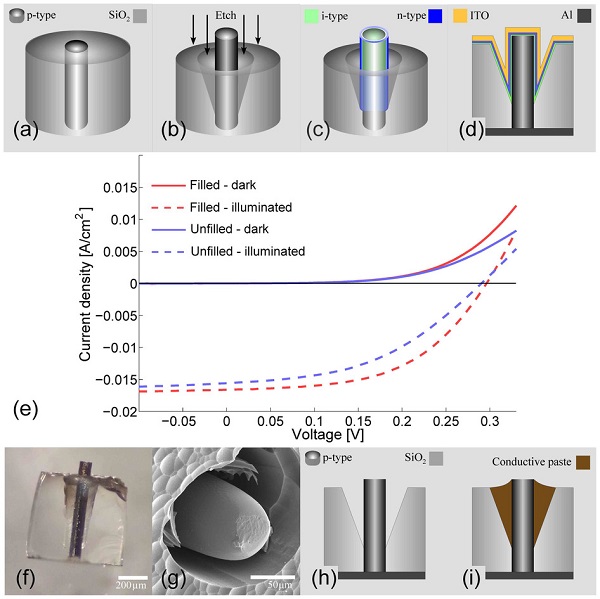A new method of producing solar cells could reduce the amount of silicon per unit area by 90 per cent compared to the current standard. With the high prices of pure silicon, this will help cut the cost of solar power.
In-Depth Story:
Researchers at the Norwegian University of Science and Technology have pioneered a new approach to manufacturing solar cells that requires less silicon and can accommodate silicon with more impurities than is currently the standard. Those changes mean that solar cells can be made much more cheaply than at present.
The advantage with such a new method of producing solar cells could reduce the amount of silicon per unit area by 90 per cent compared to the current standard. With the high prices of pure silicon, this will help cut the cost of solar power.
“We’re using less expensive raw materials in smaller amounts, we have production fewer steps and have potentially lower total energy consumption,” PhD candidate Fredrik Martinsen and Professor Ursula Gibson of the Department of Physics at NTNU explain.
They recently published their technique in Scientific Reports.
Their processing technique allows them to make solar cells from silicon that is 1000 times less pure, and thus less expensive, than the current industry standard.

Processing of a single fibre segment into a solar device: 450 μm segments (a) were selectively etched with HF from one side, resulting in the fibre core being mostly exposed (b) and (f) with a cavity around the fibre core due to the higher etch rate for CaO compared to SiO2. Deposition of a-i-Si and a-n-Si layers on top of the exposed wire using PECVD formed the p-i-n junction (c). A schematic representation (d) and an SEM image (g) of a processed solar cell and the dark and illuminated I-V curves (e) for a silicon wire with a diameter of 113 μm are shown for both an as-made cell (h) and with the cavity filled with opaque conductive paste (i).
Glass fibres with a silicon core
The researchers’ solar cells are composed of silicon fibres coated in glass. A silicon core is inserted into a glass tube about 30 mm in diameter. This is then heated up so that the silicon melts and the glass softens. The tube is stretched out into a thin glass fibre filled with silicon. The process of heating and stretching makes the fibre up to 100 times thinner.
This is the widely accepted industrial method used to produce fibre optic cables. But researchers at the Department of Physics at NTNU, working with collaborators at Clemson University in the USA, are the first to use silicon-core fibres made this way in solar cells. The active part of these solar cells is the silicon core, which has a diameter of about 100 micrometres.
Lower energy consumption
This production method also enabled them to solve another problem: traditional solar cells require very pure silicon. The process of manufacturing pure silicon wafers is laborious, energy intensive and expensive. “We can use relatively dirty silicon, and the purification occurs naturally as part of the process of melting and re-solidifying in fibre form”, says Gibson. “This means that you save energy, and several steps in production.”
It is estimated to take roughly one-third of the energy to produce solar cells with this method compared to the traditional approach of producing silicon wafers.
Gibson has worked for several years to combine purification and solar cell production. She got the idea for the project after reading an article on silicon core fibres by John Ballato at Clemson University in South Carolina, who is at the forefront of research in fibre optics materials development.
“I saw that the method he described could also be used for solar cells,” she said, “and we developed a key technique at NTNU that improved the fibre quality.” Gibson and her research group began to work with Ballato, who is a co-author of the article published in Scientific Reports.
Silicon rods
The new type of solar cells are based on the vertical rod radial-junction design, which is a relatively new approach. The design uses less pure silicon that a planar cell, Martinsen explains, and then launches into a crash-course on the inner workings of a solar cell: photons of different wavelengths are absorbed in different layers of the silicon wafer. They generate free charges, or charge carriers, which are then separated to provide electrical energy.
These charges need to be close to the electrodes and close to the p-n junction to be captured. The p-n junction is the active region in the device – where different types of charge carriers are separated. If the charge is not captured, the energy dissipates and goes to heating up the solar cell itself.
In a traditional solar cell, the journey from where a charge is generated to the surface can be quite long. This means that highly purified silicon is required. But with silicon fibres, there is a junction all the way around the fibre. The distance from where the charge is generated to where it is captured is quite short. Charge carriers can be captured effectively, even when using impure silicon.
“The vertical rod design still isn’t common in commercial use. Currently, silicon rods are produced using advanced and expensive nano-techniques that are difficult to scale,” Martinsen says. “But we’re using a tried and true industrial bulk processes, which can make production a lot cheaper.”
Potential
The power produced by prototype cells is not yet up to commercial standards. Contemporary solar cells have an efficiency of about 18 per cent. The prototype created by NTNU researchers has only reached about 3.6 per cent. Gibson and Martinsen still have faith in the potential of this production method, and are working to improve the design and fabrication processes.
“These are the first solar cells produced this way, using impure silicon. So it isn’t surprising that the power output isn’t very high,” says Martinsen. “It’s a little unfair to compare our method to conventional solar cells, which have had 40 years to fine-tune the entire production process. We’ve had a steep learning curve, but not all the steps of our process are fully developed yet. We’re the first people to show that you can make solar cells this way. The results are published, and the process is set in motion.”
The next step is to refine production, make larger and more effective solar cells, and couple multiple cells together.
References:
Article: Cheaper silicon means cheaper solar cells written by Lars Martin Hjorthol — Published Oct. 22nd, 2014 for Gemini
Publication: F. A. Martinsen et al: Silicon-core glass fibres as microwire radial-junction solar cells. Scientific Reports, 2014.













Comments